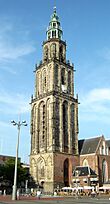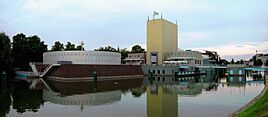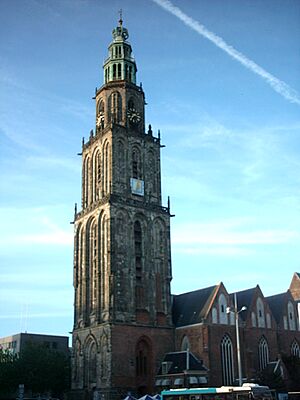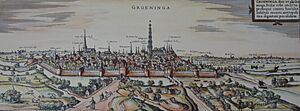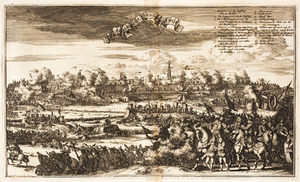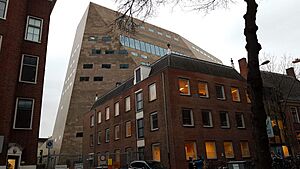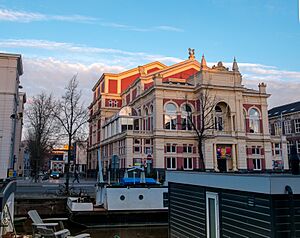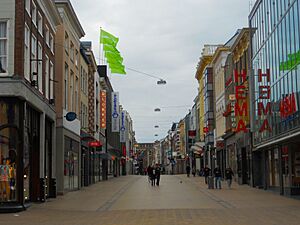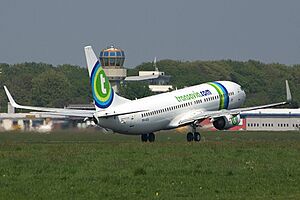Groningen facts for kids
Quick facts for kids
Groningen
Grunn(en) (Gronings)
|
|||||
|---|---|---|---|---|---|
|
City and municipality
|
|||||
|
Gasunie building
Grote Markt Square
Groningen City Theater
Aa Church/Korenbeurs
Martini Tower
Goudkantoor
Groninger Museum
|
|||||
|
|||||
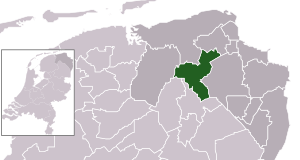
Location in Groningen
|
|||||
| Country | |||||
| Province | Groningen | ||||
| City Hall | Groningen City Hall | ||||
| Government | |||||
| • Body | Municipal council | ||||
| Area | |||||
| • Municipality | 83.75 km2 (32.34 sq mi) | ||||
| • Land | 78.05 km2 (30.14 sq mi) | ||||
| • Water | 5.70 km2 (2.20 sq mi) | ||||
| Elevation | 7 m (23 ft) | ||||
| Highest elevation | 12 m (39 ft) | ||||
| Population
(January 1st 2023)
|
|||||
| • Municipality | 238 147 | ||||
| • Density | 2,535/km2 (6,570/sq mi) | ||||
| • Urban | 216,655 | ||||
| • Metro | 360,748 | ||||
| Demonym(s) | Groninger, Stadjer | ||||
| Time zone | UTC+1 (CET) | ||||
| • Summer (DST) | UTC+2 (CEST) | ||||
| Postcode |
9700–9747
|
||||
| Area code | 050 | ||||
| Click on the map for a fullscreen view | |||||
Groningen is a lively city in the Netherlands. It is the capital of the Groningen province. People often call it the "capital of the north" because it is the biggest and most important city in the northern part of the country. As of late 2021, about 235,000 people lived there. This makes it one of the largest cities in the Netherlands.
Groningen was founded over 950 years ago. It officially became a city in 1245. Because it was a bit far from other big Dutch cities, Groningen learned to rely on itself. It was part of the Hanseatic League, a group of trading cities in Northern Europe. Later, it became a major market town for its region. In the 15th century, Groningen was almost like its own small country! It stayed independent until the French era.
Today, Groningen is famous for its universities. It has some of the best colleges in the country. The University of Groningen is the second oldest university in the Netherlands. The Hanze University of Applied Sciences is also here. About 25% of the people living in Groningen are students. This makes it the youngest city in the Netherlands!
Contents
- What's in a Name? The Story of Groningen's Name
- Groningen Through Time: A Brief History
- Groningen's Location and Weather
- Groningen's Economy: How the City Makes Money
- Who Lives in Groningen? Demographics
- Groningen's Culture: Arts, Music, and Fun
- Education: Learning in Groningen
- Transport: Getting Around Groningen
- Famous People from Groningen
- Images for kids
- See also
What's in a Name? The Story of Groningen's Name
The name 'Groningen' has a mysterious past. No one is completely sure where it came from. Some old stories say that a group of people from Troy (an ancient city) founded the settlement in 453 BC. They were led by a mythical hero named Gruno. They supposedly built a castle called 'Grunoburg'.
A more modern idea is that 'Groningen' means 'among the people of Groni'. This comes from an old name for a small lake nearby. Since Grone is an old Frisian name, it might mean the settlement was started by the Grone family. Another idea is that the name comes from groenighe, which means 'green fields'.
In the Frisian language, the city is called Grins. People in the Groningen province sometimes call it Loug. Locals often just say Stad, which means "the city". The people who live there are called Stadjers. Sometimes, the Dutch call it "the Metropolis of the North" or Martinistad. This last name comes from the famous Martinitoren tower.
Groningen Through Time: A Brief History
The city of Groningen was built on the northern tip of an area called the Hondsrug. The first official mention of Groningen is from 1040. However, people lived here much earlier. The oldest signs of a settlement are from around 3950–3650 BC. The first big settlement in Groningen dates back to 3 AD.
In the 13th century, Groningen became an important place for trade. Its people built a city wall to show their power. The city had a big influence on the areas around it. The local Gronings dialect became widely spoken. The city was strongest at the end of the 15th century. During this time, it even controlled the nearby province of Friesland. The famous Martinitoren tower was built then. It is still the city's most important landmark.
In 1536, Groningen became part of the empire of Emperor Charles V. He was the King of Spain and ruler of the Netherlands. This ended Groningen's independence. In 1594, Dutch and English forces, led by Maurice of Nassau, captured the city. After this, Groningen and its province joined the Dutch Republic.
During the 17th century, Groningen was a key place for the Dutch West India Company (WIC). This powerful company managed trade and exploration by sea. Ships from Groningen's shipyards sailed to different parts of the world. They brought back valuable goods like sugar, coffee, and tobacco to Europe.
The University of Groningen started in 1614. It first taught law, medicine, theology, and philosophy. The city grew quickly during this time, and a new city wall was built.
In 1672, the city faced a big attack by the bishop of Münster, Bernhard von Galen. But Groningen's city walls held strong! This event is celebrated every year on August 28th. It is called "Gronings Ontzet" or "Bommen Berend" ("Bombing Bernard"). In the early 1800s, Groningen became part of the French Empire under Emperor Napoleon I. It was called Groningue then.
During World War II, the main square and the Grote Markt were mostly destroyed in the Battle of Groningen in April 1945. Luckily, the Martinitoren church, the Goudkantoor, and the city hall were not damaged.
Groningen's Location and Weather
There is a town named after Groningen in Saramacca District, Suriname. This was a Dutch colony. It was named after Jan Wichers, a Dutch governor-general from Groningen. He built a fort there in 1790.
Canals: Waterways of the City
Many canals, called diep locally, surround Groningen. The main canals that leave the city are the Van Starkenborghkanaal, Eemskanaal, and Winschoterdiep. Groningen's canals were once very important for trade and transport. They have been used for trade for over a thousand years. Old warehouses along the canals, like at Noorderhaven, stored goods.
Climate: What's the Weather Like?
Groningen has a mild, oceanic climate. This is typical for the Netherlands. However, winters can be a bit colder than in other big Dutch cities. This is because Groningen is located more to the northeast. The weather is affected by the North Sea, which brings winds and gales.
Summers are usually warm and a bit humid. Temperatures can sometimes reach 30 °C (86 °F) or higher. The average high is around 22 °C (72 °F). It often rains a lot, especially in spring and summer. The city gets about 800 mm (31 in) of rain each year. It can be quite cloudy, with less than 1600 hours of sunshine per year.
Winters are cool, usually above freezing. But frosts are common when easterly winds blow. Night temperatures can drop to −10 °C (14 °F) or lower during cold spells. The coldest temperature ever recorded was −26.8 °C (−16.2 °F) in 1956. Snow often falls, but it usually melts quickly because of warmer daytime temperatures. Still, you can expect snowy days every winter.
| Climate data for Groningen (Groningen Airport Eelde), 1991–2020 normals, extremes 1906–present | |||||||||||||
|---|---|---|---|---|---|---|---|---|---|---|---|---|---|
| Month | Jan | Feb | Mar | Apr | May | Jun | Jul | Aug | Sep | Oct | Nov | Dec | Year |
| Record high °C (°F) | 14.5 (58.1) |
18.9 (66.0) |
24.0 (75.2) |
28.8 (83.8) |
32.8 (91.0) |
33.8 (92.8) |
36.9 (98.4) |
36.3 (97.3) |
32.6 (90.7) |
27.4 (81.3) |
19.4 (66.9) |
15.4 (59.7) |
36.9 (98.4) |
| Mean daily maximum °C (°F) | 5.2 (41.4) |
6.0 (42.8) |
9.5 (49.1) |
14.2 (57.6) |
17.6 (63.7) |
20.4 (68.7) |
22.7 (72.9) |
22.6 (72.7) |
19.0 (66.2) |
14.2 (57.6) |
9.0 (48.2) |
5.9 (42.6) |
13.9 (57.0) |
| Daily mean °C (°F) | 2.8 (37.0) |
3.0 (37.4) |
5.5 (41.9) |
9.0 (48.2) |
12.5 (54.5) |
15.4 (59.7) |
17.5 (63.5) |
17.3 (63.1) |
14.1 (57.4) |
10.3 (50.5) |
6.3 (43.3) |
3.5 (38.3) |
9.8 (49.6) |
| Mean daily minimum °C (°F) | 0.1 (32.2) |
−0.1 (31.8) |
1.4 (34.5) |
3.7 (38.7) |
7.0 (44.6) |
9.9 (49.8) |
12.2 (54.0) |
11.9 (53.4) |
9.6 (49.3) |
6.3 (43.3) |
3.2 (37.8) |
0.8 (33.4) |
5.5 (41.9) |
| Record low °C (°F) | −22.0 (−7.6) |
−22.9 (−9.2) |
−18.4 (−1.1) |
−8.1 (17.4) |
−3.4 (25.9) |
0.1 (32.2) |
2.5 (36.5) |
3.2 (37.8) |
−1.0 (30.2) |
−6.9 (19.6) |
−13.6 (7.5) |
−22.0 (−7.6) |
−22.9 (−9.2) |
| Average precipitation mm (inches) | 72.7 (2.86) |
54.7 (2.15) |
54.1 (2.13) |
41.3 (1.63) |
57.9 (2.28) |
65.0 (2.56) |
85.0 (3.35) |
77.8 (3.06) |
75.4 (2.97) |
71.4 (2.81) |
70.0 (2.76) |
79.4 (3.13) |
804.7 (31.68) |
| Average precipitation days (≥ 1 mm) | 13.3 | 10.6 | 10.3 | 8.5 | 9.5 | 10.3 | 11.7 | 11.5 | 11.1 | 12.1 | 13.2 | 14.0 | 136.1 |
| Average snowy days | 8 | 7 | 5 | 2 | 0 | 0 | 0 | 0 | 0 | 0 | 3 | 6 | 33 |
| Average relative humidity (%) | 90 | 88 | 85 | 79 | 79 | 81 | 82 | 83 | 86 | 89 | 91 | 92 | 85 |
| Mean monthly sunshine hours | 60.7 | 86.1 | 139.0 | 188.7 | 218.0 | 198.6 | 212.3 | 196.3 | 150.7 | 112.9 | 63.4 | 56.1 | 1,682.8 |
| Source: Royal Netherlands Meteorological Institute | |||||||||||||
Groningen's Economy: How the City Makes Money
The hotel and restaurant businesses are a big part of Groningen's economy. Over time, the city has focused more on business services. Areas like IT, life sciences, tourism, energy, and environment have grown a lot.
Until 2008, there were two large sugar factories in the city. One factory, Suiker Unie, closed in 2008. As of 2017, CSM Vierverlaten in Hoogkerk is the only beet sugar factory left. Other important companies from Groningen include the publishing company Noordhoff Uitgevers. There's also the tobacco company Niemeyer. Other notable businesses are health insurance company Menzis, distillery Hooghoudt, and natural gas companies GasUnie and GasTerra.
Who Lives in Groningen? Demographics
As of 2020, Groningen had a total population of 232,874 people.
| Country/Territory | Population |
|---|---|
| 175,249 | |
| 6,427 | |
| 5,847 | |
| 3,959 | |
| 3,401 | |
| 2,321 | |
| 2,172 | |
| 1,774 | |
| 1,768 | |
| 1,401 | |
| 1,391 | |
| 1,266 | |
| 1,157 | |
| 1,050 | |
| Other | 11,992 |
| 2020 | Numbers | % |
|---|---|---|
| Dutch natives | 175,249 | 75.2% |
| Western migration background | 29,365 | 12.6% |
| Non-Western migration background | 28,260 | 12.1% |
| Indonesia | 5,847 | 2.51% |
| Netherlands Antilles and Aruba | 3,959 | 1.7% |
| Suriname | 3,401 | 1.46% |
| Turkey | 1,774 | 0.76% |
| Morocco | 1,266 | 0.54% |
| Total | 232,874 | 100% |
Religion: Beliefs in Groningen
Most people in Groningen, over 70%, do not belong to a religion. Christianity is the largest religion, with 25.1% of the population.
Religions in Groningen (2013) No affiliation (71.7%) Protestant Church in the Netherlands (14.1%) Roman Catholic (6.3%) Other Christian denominations (4.7%) Islam (2.1%) Hinduism (0.6%) Buddhism (0.3%) Judaism (0.2%)
Population Growth: How Groningen Has Grown
| Historical population | ||
|---|---|---|
| Year | Pop. | ±% p.a. |
| 1400 | 5,000 | — |
| 1560 | 12,500 | +0.57% |
| 1600 | 16,600 | +0.71% |
| 1721 | 20,680 | +0.18% |
| 1770 | 23,296 | +0.24% |
| 1787 | 22,000 | −0.34% |
| 1795 | 23,770 | +0.97% |
The city of Groningen has grown very quickly. In 1968, it became bigger by joining with Hoogkerk and Noorddijk. In 2019, it merged with Haren and Ten Boer.
Groningen has a land area of about 168.93 km2 (65.22 sq mi). Including water, its total area is 180.21 km2 (69.58 sq mi). About 1,367 people live in each square kilometer. The larger Groningen-Assen area has about half a million people.
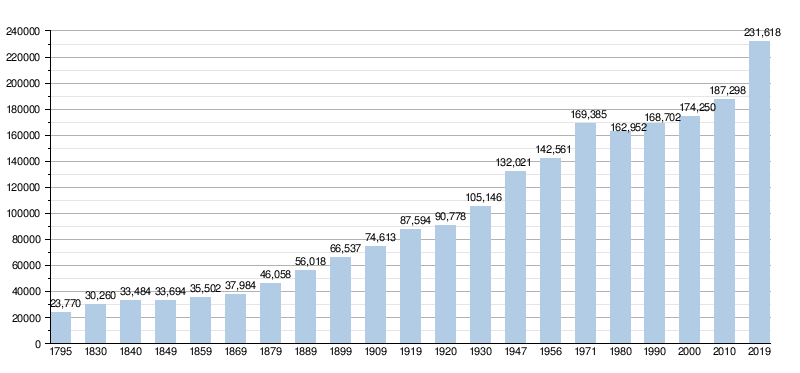
Groningen's Culture: Arts, Music, and Fun
Groningen is known as the "Metropolis of the North". It is seen as the main city for education, business, music, and other arts in northern Netherlands. It is also called "Martinistad". This name refers to the Martinitoren tower, which is named after Martin of Tours, Groningen's patron saint. The large number of students also makes the city's cultural scene very diverse.
Since 2016, Groningen has hosted the International Cycling Film Festival. This is an annual film festival for movies about bicycles. It takes place in an old Roman Catholic Hospital that is now an art house cinema.
The first big international chess tournament after World War II was held in Groningen in 1946. It was the first time the Soviet Union sent a team to an event outside their country. Since then, an international chess tournament called "Schaakfestival Groningen" has been held almost every year.
Museums: Exploring History and Art
Groningen is home to the Groninger Museum. Its new building, designed in 1994, is famous for its modern and colorful style. The city also has a maritime museum (about ships and the sea), a university museum, a comics museum, and a graphics museum. Groningen is also where Noorderlicht is located. This is an international photography group that has a photo gallery and organizes a photo festival. The Forum Groningen, which opened in 2019, is a cultural center. It has a museum, an art cinema, a library, cafes, a rooftop terrace, and a tourist information office.
Theatre and Music: Entertainment for Everyone
Groningen has a city theatre called the Stadsschouwburg. There is also a theatre and concert hall called Martini Plaza. The Oosterpoort is another cultural venue. Vera is a popular spot for music. The Grand Theatre is on the Grote Markt, and Simplon is on the Boterdiep. Many cafes have live music, and some specialize in jazz, like the Jazzcafe De Spieghel. Groningen also hosts Eurosonic Noorderslag. This is an annual music event that showcases bands from all over Europe.
Nightlife: Fun After Dark
Groningen's lively nightlife is largely thanks to its student population. The Grote Markt, Vismarkt, Poelestraat, and Peperstraat are busy every night. Most bars stay open until five in the morning. From 2005 to 2007, Groningen was even named the "best city center" in the Netherlands.
Sports: Get Active in Groningen
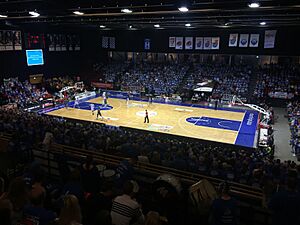
FC Groningen is the local football club, started in 1971. Since 2000, they have played in the Eredivisie, which is the top football league in the Netherlands. They won the KNVB Cup in the 2014–15 season. Their best league finish was third place in 1990–91. Their current stadium, the Hitachi Capital Mobility Stadion, opened in 2006 and has 22,525 seats.
American sports are also quite popular in Groningen. The city has teams for American football, baseball, and basketball. Groningen's professional basketball team, Donar, plays in the top league. They have won the national championship seven times. The Groningen Giants are the city's American football team. They play in the top league of the AFBN and are known as the "Kings of the North".
The 4 Miles of Groningen is a running event held every year in October. Over 23,000 people take part. Groningen was also the starting point for the 2002 Giro d'Italia, a famous cycling race. The city also hosted the start and finish of a stage in the 2013 Energiewacht Tour.
Education: Learning in Groningen


In 2020, about 25% of Groningen's 230,000 residents were students. This means Groningen has the most students and the youngest average age in the Netherlands.
There are also middle schools, like H.N. Werkman College.
The University of Groningen (in Dutch: Rijksuniversiteit Groningen), started in 1614. It is the second oldest university in the Netherlands. Famous people who studied there include Aletta Jacobs, the first female student in the country. Also, Wubbo Ockels, the first Dutch astronaut, and Wim Duisenberg, the first president of the European Central Bank. Two Nobel laureates also studied there: Heike Kamerlingh Onnes (Physics) and Ben Feringa (Chemistry). The university has about 31,000 students, with 22% coming from other countries.
The Hanze University of Applied Sciences (in Dutch: Hanzehogeschool Groningen) was founded in 1986. This university focuses on using knowledge in practical ways. It offers bachelor's and master's degrees in fields like Electrical Engineering and Renewable Energy. Hanze has over 28,000 students, with about 8.1% being international students. It is one of the largest universities of applied sciences in the Netherlands.
Transport: Getting Around Groningen
Cycling and Walking: A Bike-Friendly City
Groningen is known as the "World Cycling City". About 57% of its residents ride a bicycle for their daily travel within the city. In 2000, Groningen was named the Fietsstad 2002, the top cycling city in the Netherlands. Like most Dutch cities, Groningen has made it easy for cyclists. There is a large network of bike paths. These paths make it more convenient to cycle than to drive a car.
The city has separate bike paths and a large area in the city center just for people walking. Groningen's city center was changed to be a "pedestrian priority zone". This means walking and biking are favored. This was done by making it harder for cars to drive through the center. Streets that don't allow cars connect to paths for walking and biking. These paths go through public squares, making the city more beautiful and fun to explore.
Public Transport: Trains and Buses
Trains: Connecting Groningen
Groningen railway station (called Hoofdstation in Dutch) is the main train station. It has regular trains to most major cities in the country. The city has two other train stations: Europapark and Noord.
Groningen has six main train routes:
- Groningen – Delfzijl
- Groningen – Roodeschool / Eemshaven
- Groningen – Leeuwarden
- Groningen – Veendam
- Groningen – Weener / Leer
- Groningen – Meppel / Zwolle
On these routes, ten train lines stop at various stations, connecting Groningen to many towns and cities.
Buses: City and Regional Travel
|
City & Q-Link Lines:
Q-Liner Lines:
Night Lines:
|
Regional lines:
Other Lines:
|
You can also find direct bus routes from Groningen to cities like Bremen, Hamburg, Berlin, and Munich.
Motorways: Driving to Groningen
The A28 motorway connects Groningen to Utrecht. It passes through Assen, Zwolle, and Amersfoort. The A7 motorway connects Groningen to Friesland and Zaandam in the west. To the east, it connects to Winschoten and Leer.
Airport: Flying from Groningen
Groningen Airport Eelde is an international airport close to Eelde. It has flights to places like Guernsey, Gran Canaria, Antalya, Crete, Mallorca, and Bodrum.
Famous People from Groningen
- Abel Janszoon Tasman (1603–1659), an explorer and merchant for the Dutch East India Company.
- Albert Dominicus Trip van Zoudtlandt (1776–1835), a lieutenant-general in the Battle of Waterloo.
- Geert Adriaans Boomgaard (1788–1899), a soldier and the first person confirmed to live over 100 years.
- Heike Kamerlingh Onnes (1853–1926), a physicist and Nobel Prize winner.
- Dirk Jan de Geer (1870–1960), a statesman and former Prime Minister of the Netherlands.
- A. W. L. Tjarda van Starkenborgh Stachouwer (1888–1978), the last colonial Governor-General of the Netherlands East Indies.
- Michel Velleman (1895–1943), a Jewish magician.
- Jan Wolthuis (1903–1983), a lawyer.
- Esmée van Eeghen (1918–1944), a Dutch resistance member during World War II.
- Pete Hoekstra (born 1953), a former United States ambassador to the Netherlands.
- Gerard Kemkers (born 1967), a speed skating bronze medalist at the 1988 Winter Olympics.
- Anda Kerkhoven (1919–1945), another Dutch resistance member.
- Bauke Mollema (born 1986), a cyclist.
- Kim Feenstra (born 1985), a model.
- Ben Woldring (born 1985), an internet entrepreneur.
- Luciano Valente (born 2003), a professional footballer.
- Noisia, music producers.
- Vicetone, a DJ and music producer duo.
Images for kids
See also
 In Spanish: Groninga para niños
In Spanish: Groninga para niños






